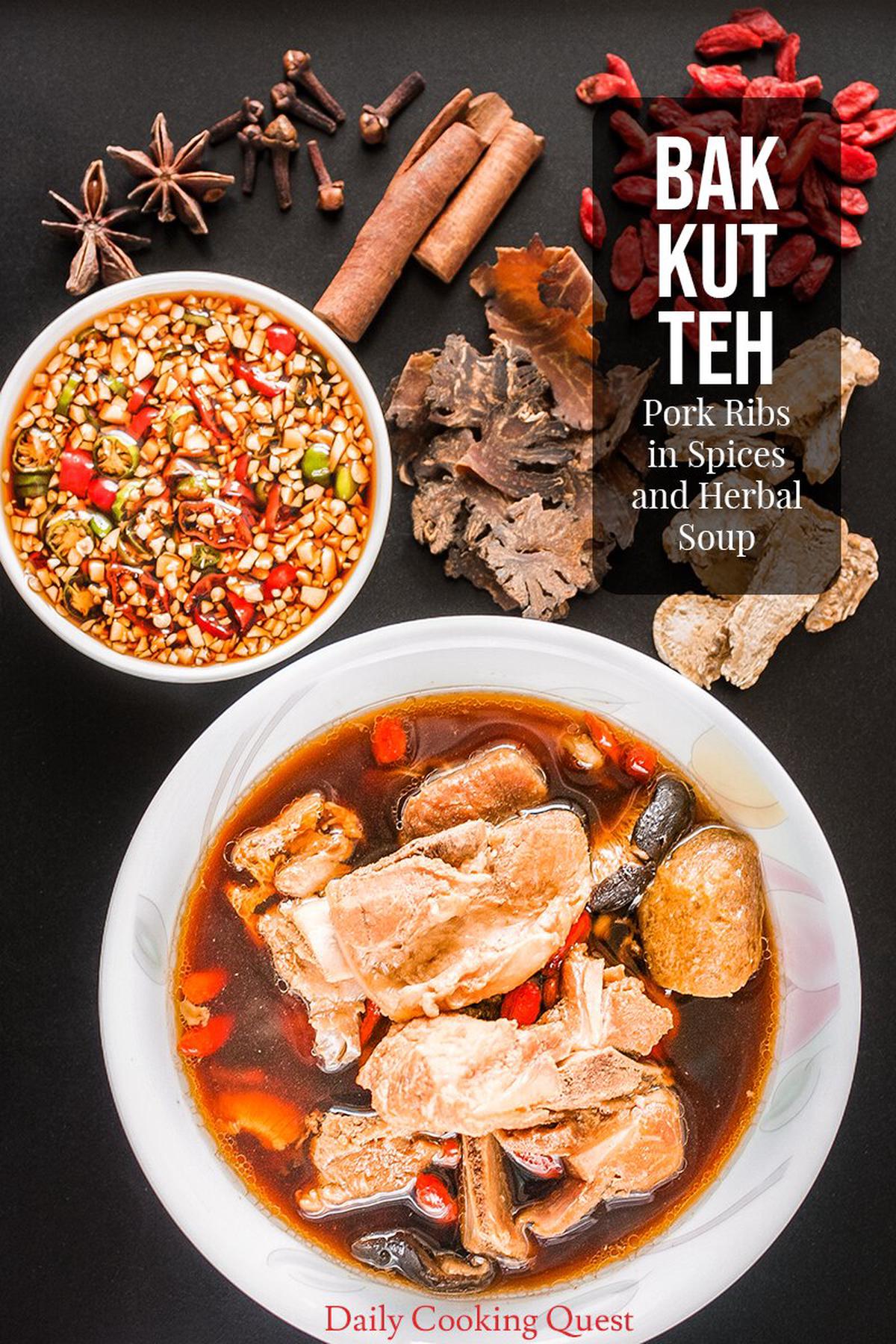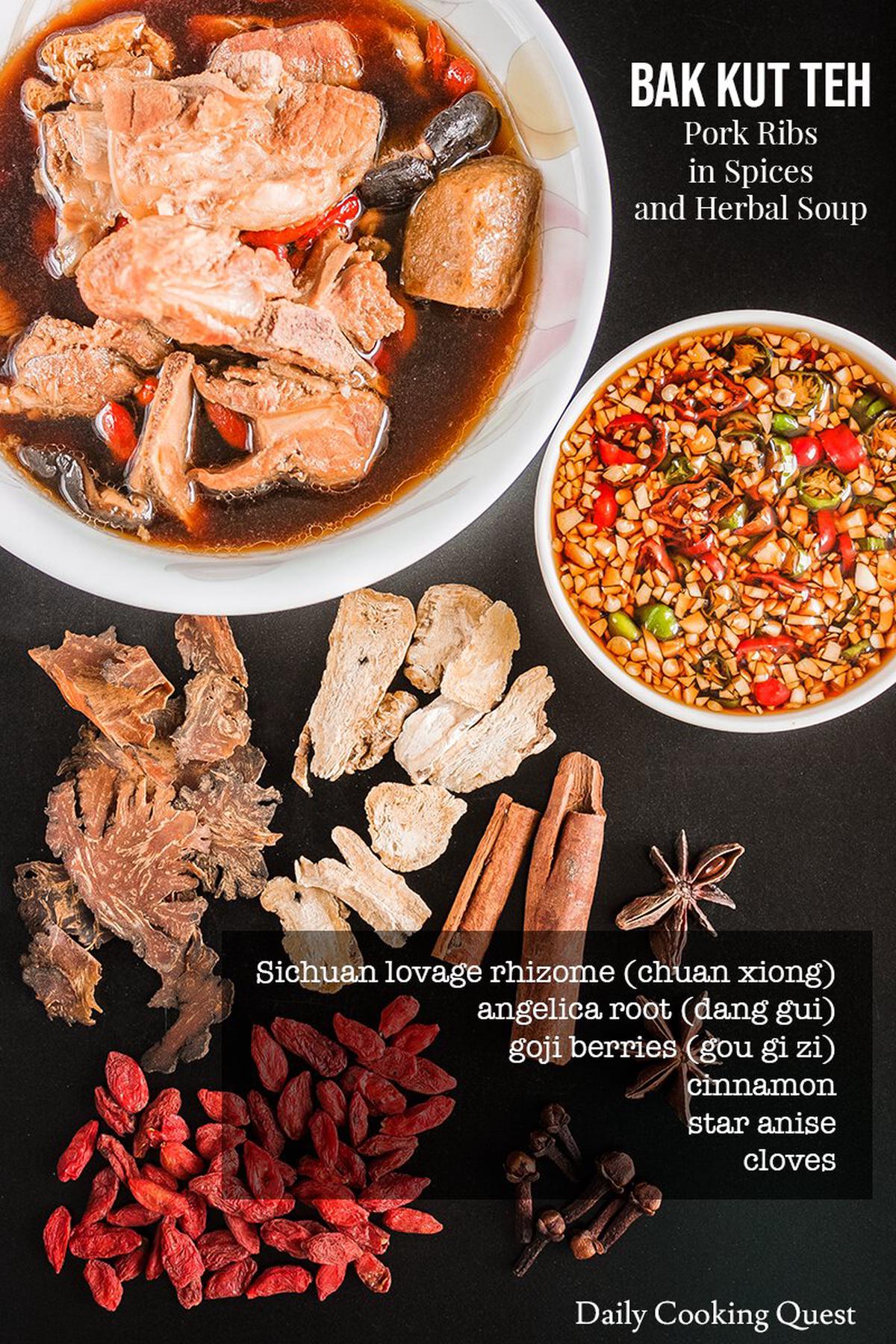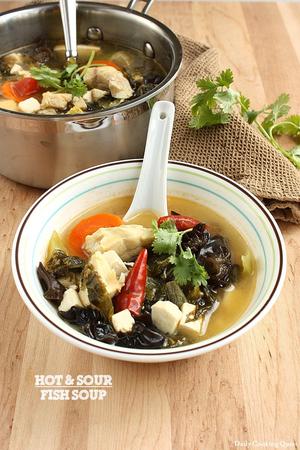Home / All Recipes / Chinese / Bak Kut Teh - Pork Ribs in Spices and Herbal Soup
Bak Kut Teh - Pork Ribs in Spices and Herbal Soup
How to prepare bak but teh from scratch (no need to use prepackaged spices) just like the one you find in Malaysia or Singapore.
Bak kut teh is a Chinese pork ribs soup cooked with many Chinese herbs, typically served with steamed white rice, you tiao (Chinese crullers), and thinly sliced chilies and minced garlic with soy sauce. It has been a long while since I had bak kut teh, and I miss it so much.
I spent close to two years in Malaysia and it was one of my many favorite Malaysian food. I used to have this all the time from the night market with my friends, and it was really really good, I think it must be the combination of good food and good company :)

Fast forward some years later when I was in the States, I found a bak kut teh recipe from a Malaysian/Singaporean/Indonesian cookbook and I made it with a huge success.
That book was such a little treasure to me since it has many of my favorite recipes, and being such a newbie in the kitchen at that time, it has been so useful. Unfortunately, I no longer have the book with me, so it has been a frenzy hunt for a reliable bak kut teh recipe again.
I think this recipe is really close to the one that I had in Malaysia, or maybe I just miss this dish so much, haha. Anyway, if you love bak kut teh and would like to gather the spices from scratch (not using expensive prepackage bak kut teh spices), this might be a good reference. ♥

Bak Kut Teh - Pork Ribs in Spices and Herbal Soup
Ingredients
- 800 gram pork ribs
- 2 liter water
- 10 gram angelica root (Chinese: dang gui)
- 5 gram Sichuan lovage rhizome (Chinese: chuan xiong)
- 1 head garlic (Indonesian: bawang putih), peeled and lightly bruised
- 1 cinnamon stick (Indonesian: kayu manis)
- 1 star anise (Indonesian: bunga lawang/pekak)
- 5 cloves (Indonesian: cengkeh)
- 2 tablespoon dark soy sauce
- 1 tablespoon light soy sauce (or regular soy sauce)
- 2 teaspoon salt
- 1 teaspoon sugar
- 8 fresh shiitake (Indonesian: jamur shiitake), remove stems and cut into bite size pieces
- 8 deep fried tofu (Indonesian: tahu goreng), blanched in hot water and cut into bite size pieces
- 1 tablespoon goji berries (Chinese: gou qi zi)
- Chili and garlic soy sauce (mix the following together)
- 3 green Thai chilies (Indonesian: cabe rawit hijau)
- 3 red Thai chilies (Indonesian: cabe rawit merah)
- 3 cloves garlic (Indonesian: bawang putih)
- 3 tablespoon light soy sauce (or regular soy sauce)
Instructions
- Place pork ribs and water in a soup pot and bring to a boil. Keep removing the scum until the soup is clear.
- Once the soup is clear, add angelica root, lovage rhizome, garlic, cinnamon, star anise, and cloves. Season with dark soy sauce, soy sauce, salt, and sugar. Once it boils again, reduce heat, cover the pot with a lid, and simmer for 1 hour, or until the pork is cooked and tender.
- Add shiitake, tofu, and goji berries into the pot. Bring to a boil again, and cook for another 10 minutes. Adjust with salt and sugar as needed.
- Turn off heat, and serve hot with the chili and garlic soy sauce accompanied with a bowl of steamed white rice and you tiao (Chinese crullers).






Comments
I tried this version last night and I do say it was very good! Eventhough I did not have any Sichuan (Chuan Xiong) the soup still came out very tasty. Lots of compliments last night. Thanks for posting this recipe!
Thanks for this receipe. now i can cook some home food when i m alone in overseas ;-)
Hi Anita, apa kabar? Saya juga seorang food lover seperti anda, kebetulan mencari2 receipe buat bak kut teh dan ketemu salah satunya punya anda. Terima kasih sekali. Saya baru sekali mencoba membuat bak kut teh tetapi masih memakai yg packaged herbs, dan dlm waktu dekat akan mencoba memakai yg fresh herbs seperti yg anda katakan. Oya kemaren baru jalan2 ke Jakarta sempat coba bak kut teh Song Fa yg di Hayam Wuruk, lumayan enak juga (ato sayanya memang yg doyan bak kut teh). Lain waktu ingin juga meminta food reference dari anda. Once again, thank you Anita.
This is great article Thank you for the recipe i would like try to cook this food
Dimana ya cari danggui dan sichuan rhizome? Toko obat cina? Thankyou
Hi Ria, betul, di toko obat Cina seharusnya ada kok :)
Hai anita.. Saya beberapa hari yang lalu di kasih bak kut teh dalam kemasan.. Mungkin yg package herbs.. Nah saya baru baca kalo penyimpanannya di kulkas.. Ini udh 10hari di suhu ruang.. Apa masih layak konsumsi? Terimakasih..
Halo Okky, Chinese herbs yang kering ok ok saja di suhu ruangan, kecuali kalo ada yang agak-agak basah, seperti buah longan kering. Coba dilihat saja, kalo tidak ada tanda-tanda berjamur, seharusnya masih aman untuk dikonsumsi, tetapi kalo sudah tumbuh jamur putih-putih begitu, sebaiknya dibuang.
I like it
Hi Anita, Thank you very much for your recipe. My family loves it very very much! And I also tried your Martabak Tahu.... Yummy! Thank you for sharing your recipes! Regards, Marg
I am really happy to hear that, Marg :)
Halo Anita.. Thanks for posting this recipe. Apakah masakan ini bisa dimakan untuk ibu hamil?
Halo Dewi, maaf aku tidak terlalu paham untuk efek herbal Chinese terhadap ibu hamil. Untuk amannya, sebaiknya konsultasi terlebih dahulu dengan dokter.
Menu ini pasti punya manfaat untuk kesehatan ya sis, karna sekilas aku lihat menggunakan rempah-rempah ala chinese. boleh tau manfaatnya untuk apa saja ya ?
Halo Anita.. Thanks for posting this recipe. Resep ini apakah cocok untuk ibu menyusui....
Halo Ria, maaf aku tidak terlalu paham untuk efek herbal Chinese terhadap ibu menyusui. Untuk amannya, sebaiknya konsultasi terlebih dahulu dengan dokter.
I really like the food, because I like ribs soup with spices typical. but I really do not like pork, whether it can be replaced with mutton?
To be honest, I don't know. This dish always uses pork. But given that this is Chinese soup, I think chicken is probably a better substitute.
Nice...tried the recipe...the taste was awesome...superb!!
Hi Anita, May I know which herb would you recommend to increase the quantity if I would like to have a stronger taste?
Hi Erin, I would try increasing dang gui for a more stronger Chinese herb taste, maybe to 12-15 gram.
Herbal yang sangat berkhasiat, terima kasih ats infonya
aduuhhh itu pedas gak kira-kira untuk sambal kecapnya, btw itu sambal kecap bukan yah ? hehehe
Sambal kecapnya bisa tidak pedas asalkan biji cabe rawit dibuang semua. Kalau itupun masih terlalu pedas, coba pakai cabe keriting saja ;)
Have made this recipe 4-5 times now. It is fabulous. Slow simmering for 24+ hours delivered a rich result. Thank you very much for taking the time to publish it! I have tweaked it a little with two star anise pods, but there are surely many subtle tips. So far, the longer the better! When I doubled it, I doubled the Chuan Xiong. It was too bitter. I later added one gram (6 g total for double recipe) and it turned out very well. Adding more Dang Gui did not seem to adversely affect the recipe. What do you think of adding oyster sauce? I saw some recipes listing it.
I am glad you like the recipe Hans. I think you can add a little oyster sauce if you like, it shouldn't have adverse effect to the overall taste :) I agree that chuan xiong is more on the bitter side, and for people who love a more herbal taste, it is better to add more dang gui.
It's Gou qi zi btw. But thanks for the recipe!
Haha, you are right ;) Gonna update the recipe.
Thank you very much for your recipe. My family loves it very very much! And I also tried your Martabak Tahu…. Yummy! Thank you for sharing your recipes! Regards,
You are very welcome :) I'm glad you and your family love my recipes.
i saw another version with clear soup adding only half tsp dark soy sauce. so is it with chinese herbs is better to have a darker soup? thks
Hi Lim, I think it is just a matter of preference whether to go with a lighter color soup or a darker one. If you prefer lighter color soup, feel free to use a smaller amount of soy sauce, though you may want to add a bit of salt to the soup.
Halo, senang sekali bisa nemu resep bak kut teh.. Jadi teringat dulu pas kecil pernah makan bareng keluarga makanan yang satu ini.. Thanks ya sudah share! ♥
I also lived in Malaysia for many years and have tried to make bak Kuhn the , with varying degrees os sucess, always using sachets of spices, they were never quite right. Finally tried finding out the specie spices and ratios. This was fabulous. Of course I made some modifications. I absolutely recommend to any Malaysians (and others). One tip. It really improves the longer you leave it. Like a good curry better the next day. Thank you so much
Thanks for the compliment Penny! Totally agree that the taste gets better and better as it ages, so it is always good to make a big batch to last for several days ;)
Yes I made a large batch, Actually I used pigs tails (boiled a long time the skin is gelatinous and delicious, to counteract, I add tao foo just to the serving bowl with spring onions. I am so happy to have the recipe - thanks
Ooo... pigs tails! That must be one awesome batch of bak kut teh ;)
Hi Anita, I am thrilled to find your recipe. It's been ages to search perfect blend as you discover. Will try when I'm home, at Jakarta, since I can't found Chinese herbs in Labuan Bajo, Flores (didn't know, if there where in Ruteng, the bigger city). Thank you to share the recipe. God bless good chef :)
Hi Anita, just saved the recipe and will make it during the next week! I’m sure my family will love it.
Song Fa bak kut teh, rasa merica saja. Tak ada rasa Herbal.
I admit I bought a pre-made sachet for this, but it was really helpful to read about the ingredients and I also added a few things per this recipe. If I were more confident with Chinese herbs, I'd make this all the time- it's interesting to read all the comments that describe what each ingredient does so it can be perfected to the chef's taste.
Look so delicious, I will try to combine it with rice.
Reading your post brought back so many fond memories of my time in Malaysia, especially the delicious aroma of bak kut teh from the night markets. It's amazing how food can evoke such strong emotions and nostalgia. Like you, I've also tried recreating this dish at home, and it's always a rewarding experience. Thanks for sharing your journey of rediscovering bak kut teh through a beloved cookbook. It's inspiring to see how food connects us across time and place. I'll definitely be giving your recipe a try – there's nothing quite like homemade comfort food to soothe the soul.
Leave a comment